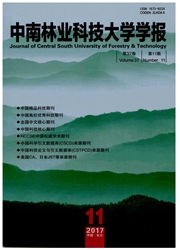

 中文摘要:
中文摘要:
探究不同磷水平施肥对油茶林土壤养分含量、微生物数量及酶活性的影响,从而确定最佳施磷水平为油茶植株营养生长和提高经济效益奠定基础。设定了每年每株植株氮最佳用量69 g和钾最佳用量99.57 g,并设置了单株年施入磷肥量:0、300、600、900、1 200 g共5个梯度,研究不同磷水平下油茶林土壤养分含量、微生物数量及酶活性的变化趋势及其相关性。结果表明:对于土壤养分而言,有效磷含量呈上升趋势,在P4磷水平呈最大值;有机质含量呈先上升后下降趋势,在P3磷水平时达到最大值;而碱解氮及速效钾呈下降趋势;对于土壤微生物数量而言,细菌、真菌、放线菌及解磷菌数量呈先上升后下降趋势,在P3磷水平时达到最大值;对于土壤酶活性而言,磷酸酶、过氧化氢酶及蔗糖酶活性呈先增加后下降趋势,在P3磷水平时达到最大值,而脲酶呈下降趋势。通过相关性分析可知,土壤养分含量、微生物数量及酶活性间相关性密切。
 英文摘要:
英文摘要:
Explore different phosphorus fertilization on the oil-tea soil nutrient content, the influence of the microbe number and enzyme activity, so as to determine the optimal p application level for camellia plant vegetative growth and lay a foundation to improve the efficiency.Set the best dosage of each plant nitrogen each year 69 g and the best dosage is 99.57 g, potassium and set the individual into the phosphate content:0, 300, 600, 900, 1 200 g, a total of five gradient under different phosphorus levels differential forest soil nutrient content and microorganism quantity and the change trend of enzyme activity and its correlation.Results show that for the soil nutrient, effective phosphorus content is on the rise, in P4 phosphorus level is maximum; Organic matter content showed a trend of decline after rising first, maximum when P3 phosphorus levels; And alkaline hydrolysis nitrogen and available potassium is on the decline; For the soil microbial number, the number of bacteria, fungi, actinomycetes and phosphate-solubilizing bacteria is on a downward trend after rising first, maximum when P3 phosphorus levels;For the soil enzyme activity, phosphatase, catalase and sucrase activity showed a trend of decline after increase first, reach maximum when P3 phosphorus levels, and urease is on the decline.Through the correlation analysis shows that the soil nutrient content, close correlation between microorganism quantity and enzyme activity.
 同期刊论文项目
同期刊论文项目
 同项目期刊论文
同项目期刊论文
 期刊信息
期刊信息
